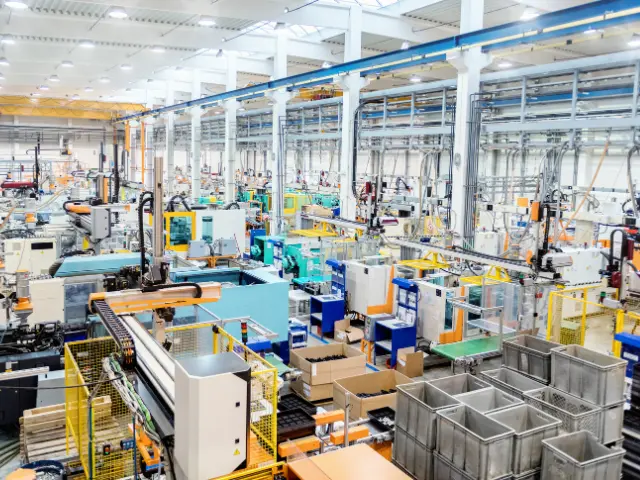Table of Contents
ToggleKnowing the differences between OEM, ODM, and OBM can be highly beneficial for buyers, particularly when managing product sourcing, customization, and brand strategy.
Understanding the advantages and disadvantages of these manufacturing models can help you plan better for scalability and risk management. For instance, an ODM works well for small-scale production, while transitioning to OEM or OBM is a common practice for growing brands.
If you’re ready to learn more, let’s take a more nuanced look at each model below.
To look for China suppliers, click here.

What is OEM?
An OEM stands for Original Equipment Manufacturer and is essentially your outsourced production team.
Simply, these companies produce components, parts, or products based from the buyer’s specifications. Hence, you provide all the ideas and design, and the OEM takes care of the manufacturing process.
This arrangement is often used by businesses that bring products to the market quickly, as well as those that focus or specialize more on design and branding.
What is ODM?
ODM (Original Design Manufacturer), on the other hand, takes charge of manufacturing and design.
As the purchasing company, your inputs are mostly limited to customization, and the core design and development are handled by the ODM.
In essence, ODMs offer ready-made prototypes of their products to be rebranded by the purchasing company. It’s a favorable option for companies that are looking to launch products quickly but don’t have the infrastructure, resources, or expertise to make designs from scratch.
What is OBM in Manufacturing?
OBM (Original Brand Manufacturer) oversees design, production, and branding. Most brands enter the market as OBM, where they are solely responsible for every stage of the product’s lifecycle, including its marketing and sales.
Essentially, brands that act as the OBM set up a factory that can scale with their production. On one hand, this model provides the most control and the highest potential for brand loyalty. However, it also requires significant investment in design, manufacturing, and marketing capabilities.
What are the Advantages and Disadvantages of Each Business Model?

Advantages of OEM
Customization
An OEM company might offer a suggestion or two, or you can ask them for insights on how the product or process can be optimized, but they will ultimately follow your specifications, designs, or patents. You will also be able to take care of the branding, marketing, and distribution as you see fit.
Competitive service rates
OEMs have an established network of parts and components supply chains, which means they can purchase materials in bulk at a lower price. Additionally, this allows them to scale their production to fit your requirements.
In particular, OEMs that are based in China tend to offer more competitive rates due to their access to low-cost OEM parts and labor.
Cost-efficiency
OEMs make it easier for brands to turn a profit with their products.
The first two points we’ve introduced also play a huge role here, since no other manufacturing model provides the level of customizations and flexible rates that OEMs can.
They also reduce downtime, because they excel in producing in bulk and maintain a very strong supply chain themselves.
Many OEMs also accept a one-time payment, which presents a good way for businesses to manage risks brought upon by potential price increases in raw materials.
Disadvantages of OEM
Time and resource-intensive
Since OEMs only specialize in manufacturing, your business will still be in charge of all other areas in the product’s life cycle, including design, research and development, and product testing.
OEMs also typically exercise a minimum order quantity requirement, which can raise issues if your brand is not yet prepared to upscale.
Competitive and crowded market
OEMs are popular in the automotive industry, consumer electronics, computers, healthcare, and other high-yielding sectors. Therefore, securing a partner locally can be a real challenge.
The good news is that there are plenty of reliable OEMs overseas, especially in China. For that, you can use Konektii’s database to search China manufacturers that specialize in your product or service.
Advantages of ODM
Accelerate product development
Partnering with an ODM means you don’t have to invest as much in hiring designers to create your own prototype, which can lead to significant savings depending on your industry.
Additionally, you’ll get more product insights since ODMs are known for their specialization or niche. Hence, you can be sure that you are dealing with professionals with the right equipment facilities, experience, and skills necessary to meet industry standards.
Reliable and tested products
The ODM will do the testing and necessary steps to acquire certifications for the product, which are typically time-consuming and complicated for certain industries.
Hence, your business may benefit from working with an ODM, as it can give you more room to focus on branding and marketing, or other facets of the business.
Disadvantages of ODM
Higher costs
ODMs are more expensive because they handle product research and manufacturing in your stead.
This arrangement can be cost-effective for some brands, while others may find it more challenging and limiting to their base operation.
Limited creative control
While you get to add a few customizations here and there, the ODM holds the key when it comes to core design and product development. If brand identity is paramount to your strategy, ODM may not be the best arrangement for your business.
Also, the IP of the product is usually retained by the ODMs, so you’ll never have proper ownership over your branded goods. This also means future improvements or redesigns to the said product can be tricky and costly.
Advantages of OBM
Complete control
The OBMs get full control over product design, branding, IP, and quality standards.
Having more control over the entire production process also means these businesses have full authority over pricing, which often makes them more flexible in their market.
With OBM, you have more opportunities to build a strong, unique brand identity that consumers can recognize and get behind.
Quality assurance
Since you are managing the entire product life cycle, you can ensure top-notch quality in the process and the end product itself. This also ties in with brand identity, since many customers put a higher value on OBM products.
Disadvantages of OBM
More expensive
This manufacturing model is hard to sustain for most businesses, especially as they are experiencing rapid product growth. It’s why you’ll see a lot of OBMs transition to an OEM or ODM manufacturing model in order to accommodate market demand and focus on branding and sales.
The process can be slower
Most businesses start as an agile OBM, but as demands rise, they may encounter challenges in bringing more products out the door.
Simply put, doing everything in-house requires a huge investment in time and resources. And they also have to manage the supply chain and sales. At some point, the OBM model can put a strain on a brand’s capacity to scale.

Which is Better OEM or ODM?
If you want full creative control and have the resources, OBM is a truly powerful choice.
Even so, OBM is not always the ideal option, and you have to choose between OEM or ODM to push your business further.
To put it in perspective, if speed and cost are among the top priorities, ODM is the more stable option. Meanwhile, if you already have a game-changing design or prototype, and will only need to outsource production, OEM is definitely more suitable.
What is an Example of ODM?
Healthcare is one of the fields where ODM thrives. For example, a healthcare company that wants to expand its product line will usually outsource the core design and production of its devices and sell them under its brand name. This is also true for tech and electronics, as well as government and education sectors.
Additionally, OEM products come in many forms such as OEM car parts, OEM hardware, OEM software, replacement parts, and more.

Choosing Between ODM, OEM, and OBM
Businesses don’t have to function exclusively in a single manufacturing model. A lot of successful corporations are a bit of both, where they have their core products designed and produced in-house, and some accessories or extended lines created with partners.
A tech company, in another example, can also sell its own line of consumer electronics under its own brand, and manufacture OEM components in business-to-business sales. In this instance, the manufacturer is able to diversify its revenue stream, while also building a loyal consumer base for its own branded products.
With that said, if you’re looking to streamline your manufacturing process, you can use Konektii’s expansive database of Chinese manufacturers and suppliers to begin exploring your partnership options overseas. Every supplier in Konnektii’s directory has qualified and attended Canton Fair, China’s largest international trade expo.







